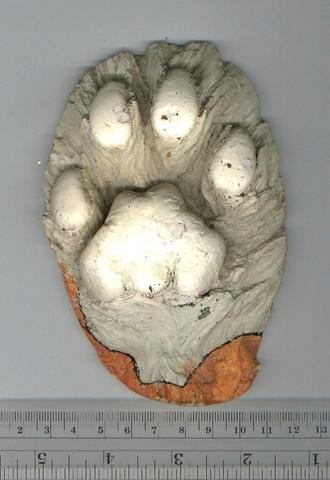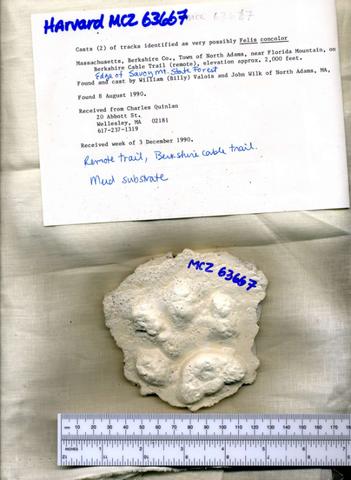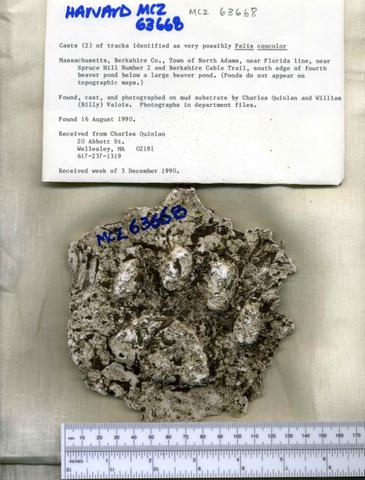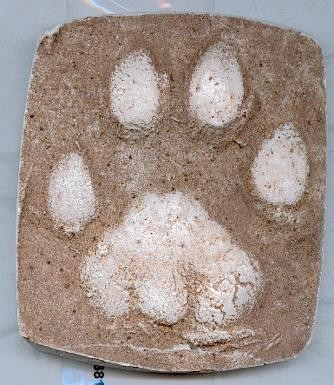
February 2, 2007

A copy (above) of an allegedly actual mountain lion (puma, cougar) track sold commercially by Acorn Products.
As you may recall, in the recent posting entitled “Eastern Cougar Catfights”, I discussed the on-going battles between the older pro-eastern felid group, Eastern Puma Research Network (EPRN), and the newer more debunking Eastern Cougar Foundation (ECF).
ECF member and mushroom expert Joseph Lankalis has “demanded” that I publish his contribution below, before it goes up on the eastern cougar page. To demonstrate how personal this feud has become, sure, I’ll post this. Lankalis’ argument may have some merit but the way he delivers his case is troubling and merely reinforces what I have said previously here about trouble in the puma country.
Another look inside the feud between cougar organizations reveals more hostility, in spite of the fact there may or may not be evidence for a hoax taking place. Sometimes the acidic comments can be directed to anyone that questions what is occurring – from either side. Please note, I am not a member of any puma, eastern cougar, or felid organization.
Lankalis says my original posting was “outrageously absurd,” and then follows up with: “I know you are a fair man and will post this on your cryptomundo to make things right. If you don’t, then that will tell me about the real you. These people [ECF members cc’ed his emails] are my witnesses.”
When I requested that he cease with the negative energy emails, he responded: “It is clear that you are an enemy to be avoided.”
Lankalis recently admitted it was not Helen McGinnis but he who is behind the “hoax” project. He feels his insights about the Bershire casts should be compared to how people now know that the following are hoaxes: “Piltdown Man, Nessy [sic], Panthera atrox [sic], and mysterious cats [sic].”
Mr. Lankalis has it all figured out and he is always ready to let everyone know he has the final word. He may be correct about the Berkshire situation, but his blanket statements regarding the discovery of a hoax or some mistakes equals the overturning of all the evidence of cryptid felids in the East only goes to demonstrate the shortsightedness of his global debunking approach.
To refresh your imagery memory and to key the following casts to the discussion that follows, please note these photos. Carefully see that #11 is used twice by Lankalis, once for his “hoax” labeled cast and the other from an allegedly known puma track.

On display at Harvard’s Museum of Comparative Zoology: The Harvard verified casts (above and directly below) of credible eastern cougar tracks found in Massachusetts in 1990. The above cast is labeled in ECF’s Hoax file as #11, the other below, ECF’s Hoax file #12 Hoax file.


The above (allegedly authentic) cast is ECF’s Track file #11.
What follows is Lankalis exposé (unedited).
^^^^^^^^^^^^^^^^^^^^^^^^^^
The Virtue of the Berkshire Casts.
In 1990, two naturalists from Massachusetts turned in two plaster casts of cougar tracks to the Museum of Comparative Zoology at Harvard. These casts were submitted as evidence of the presence of cougars in the Berkshire Mountains. Recently, these tracks were declared bogus. Even more recently that declaration was further declared unjustified and slanderous to the reputations of the two naturalists. The denouncements of the Berkshire tracks were not made without substantiation. I will explain why those tracks are bogus in this post.
I do not mention the names of the naturalists because the exact nature of the tracks’ origins is not completely understood. Did some unknown person(s) give these tracks to the naturalists, or did the naturalists fabricate them themselves. Only an honest dialogue with the naturalists will determine that. This post will not explore the origins of these track casts.
These casts were on display at the second Eastern Cougar Conference at Morgantown in 2004. There were many qualified track experts who saw them. At the time, my own experience was still too limited.
I can explain their validity by abnormalities of morphology and anatomy. I am quite certain that these tracks were man made and not misidentifications. If someone is going to make tracks by hand, he had better have a good understanding of anatomy and bone structure. A blatant error was included in the construction of these tracks. Look at them carefully. Are they right or left? True cat tracks are asymmetrical and easily distinguishable right from left. The hoaxer forgot or did not know about this.
The feet are composed of the following bones: phalanges, metacarpals, metatarsals, carpals, and tarsals. Since cats are digitigrade (walk on toes), only the distal ends of the metacarpals and metatarsals shape the track. In plantigrade animals, the entire lengths of these bones shape the tracks. The phalanges are the toe bones. The metacarpals and metatarsals form the heel pads of the front and hind feet respectively. The carpals and tarsals form the wrist and ankle bones.
The Berkshire tracks are listed as #11 and #12 in the Hoax section of the photo album. Compare them to #11 in the Tracks section. The contrasts are obviously different. Right and left are ambiguous. These bones are connected end-to-end to each other. The first phalanx connects to the second phalanx connects to the third phalanx which finally connects to the distal end of the respective metacarpal (if it is the front foot).
Notice how the lateral toes of #12 appear to be disjunct, i.e., they appear not connected to the foot. That is because the phalanges are not in a straight line with the distal end of the metacarpal. Whether it is your own hand or any other animal’s paw, the phalanges are supposed to line up in a straight line in the normal appendage. Failure to include this fact by the fabricator is a major error in anatomy. That is why the #12 is bogus.
The #11 track has the toes properly radiating away from the distal ends of the metacarpals, but the fabricator made a mistake in morphology.
Again, you cannot distinguish between right and left. Also, the toes are too large, too long, and not the proper shape. In the genuine cattrack 4TH. This an abbreviated way of saying, in a cattrack the combined area of the toe pads is less than the area of the heel pad. For dogs, it is the opposite. The #11 track is way off on proportions. Both tracks are erroneous in the exact shape of the heel pads. See #11 in the Tracks section.
I believe I have made my points quite clear as to why the Berkshire Tracks are bogus. I always try to avoid conjecture.J.A.LANKALIS
The catfight continues, as seen in yet another look inside the feud between cougar organizations. What is revealed is merely more hostilities. The reality or hoaxing of information and evidence seems hardly important in this environment where civility takes a backseat to the cult of personality.
About Loren Coleman
Loren Coleman is one of the world’s leading cryptozoologists, some say “the” leading living cryptozoologist. Certainly, he is acknowledged as the current living American researcher and writer who has most popularized cryptozoology in the late 20th and early 21st centuries.
Starting his fieldwork and investigations in 1960, after traveling and trekking extensively in pursuit of cryptozoological mysteries, Coleman began writing to share his experiences in 1969. An honorary member of Ivan T. Sanderson’s Society for the Investigation of the Unexplained in the 1970s, Coleman has been bestowed with similar honorary memberships of the North Idaho College Cryptozoology Club in 1983, and in subsequent years, that of the British Columbia Scientific Cryptozoology Club, CryptoSafari International, and other international organizations. He was also a Life Member and Benefactor of the International Society of Cryptozoology (now-defunct).
Loren Coleman’s daily blog, as a member of the Cryptomundo Team, served as an ongoing avenue of communication for the ever-growing body of cryptozoo news from 2005 through 2013. He returned as an infrequent contributor beginning Halloween week of 2015.
Coleman is the founder in 2003, and current director of the International Cryptozoology Museum in Portland, Maine.
Filed under Alien Big Cats, Artifacts, Breaking News, CryptoZoo News, Cryptozoology, Mystery Cats